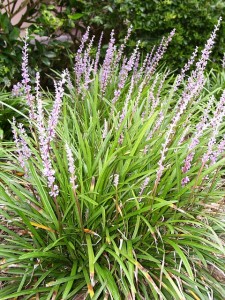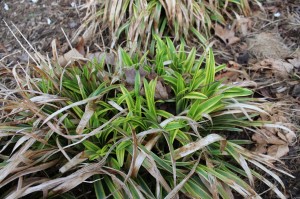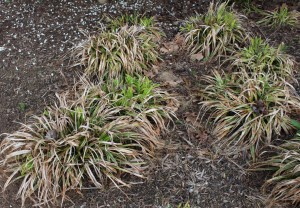Liriope in the Landscape
Whether you are planning a new landscape design or looking to make some changes to your existing landscape to make it more beautiful, there are hundreds of plant choices you could find at a local supplier. You examine trees, shrubs, and perennials, the cute specimens in their pots and looking at the small picture on their tags. But it’s tough to know if you made a good selection until it’s grown a few years. You may also ask landscapers for some advice. Occasionally we like to share some plant recommendations with you. These recommendations are plants that we love. So today we’d like to highlight a plant we frequently use, Liriope.
 Liriope is a small, grass-like perennial that can be planted for use in a variety of ways. Some varieties will have a tendency to spread, like Liriope spicataso. It can make a beautiful groundcover that has less disease and insect problems than other common alternatives such as pachysandra. It will also not be an aggressive climber like ivy. Other varieties will grow more like an organized clump. These varieties can look great when planted in groupings when there is some separation of the plants.
Liriope is a small, grass-like perennial that can be planted for use in a variety of ways. Some varieties will have a tendency to spread, like Liriope spicataso. It can make a beautiful groundcover that has less disease and insect problems than other common alternatives such as pachysandra. It will also not be an aggressive climber like ivy. Other varieties will grow more like an organized clump. These varieties can look great when planted in groupings when there is some separation of the plants.
Where to Plant Liriope?
Liriope will grow to approximately 12″-16″ tall and prefers full sun to partial shade. This low-maintenance plant has moderate needs for water, making it fairly drought-tolerant plant after it establishes after the first year. It is also a plant that deer and rabbits don’t prefer to feed on as well. Liriope is tolerant of air pollution, which allows it to be used on virtually any property. This makes it ideal whether on a commercial landscaping project or a backyard landscaping design.
What type to plant?
We mainly use 3 main types of Liriope. If we are attempting to fill an area with groundcover, the Liriope spicata variety will fill in very full. However, if you don’t want an area to spread there are 2 Lilyturf varieties that work great. Big Blue Liriope are a dark green-leaved variety as well as there is a Variegated Liriope that has a cream-to-yellow and green leaf tissue. Both of these varieties grow to the same size and have simliar characteristics except with the differing leaf color. Our landscape designers commonly use these in groupings with taller perennials behind to create layers of color and texture in the design. Liriope also looks great as a bed border or to line a walkway.
 This perennial provides multi-season interest. New growth will emerge in mid-spring in a couple weeks. In late summer, Liriope will develop showy flower spikes with tiered whorls of dense, violet-purple flowers that resemble a miniature hyacinth and will remain for a few weeks until blackish berries develop in fall and can persist into winter.
This perennial provides multi-season interest. New growth will emerge in mid-spring in a couple weeks. In late summer, Liriope will develop showy flower spikes with tiered whorls of dense, violet-purple flowers that resemble a miniature hyacinth and will remain for a few weeks until blackish berries develop in fall and can persist into winter.
What should I do to maintain liriope?
Maintaining Liriope is easy. Each season the old foliage should be removed as it will get damaged by the winter turning it brown and looking unsightly. Some property owners prefer to cut back their Liriope in the late fall so that leaves and other debris do not get caught in the plants. Liriope will retain its color, particularly the Variegated variety throughout part of the winter, especially if weather isn’t that harsh. Some property owners will allow Liriope to remain until early spring and then cut back the old foliage. To remove the foliage, use a sharp cutting tool of some sorts, either a hand-pruner or a sharp hedge shears. Just be sure to not cut the curved tops of any new emerging leaves. Cut to leave approximately 1.5″-2″ of old foliage and the new growth will obscure it when it emerges.This is just one of the many plants that can provide more beauty for a low-maintenance landscaping design on your property. If you’d like to discuss us adding Liriope or any other plants to your property we’d love to talk further with you.


